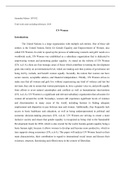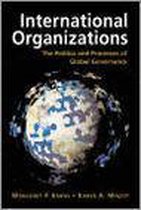Samantha Nijboer- 2078352
Total word count excluding references: 2424
UN Women
Introduction:
The United Nations is a large organization with multiple sub entities. One of these sub
entities is the United Nations Entity for Gender Equality and Empowerment of Women, also
called UN Women. In order to speed up the process of addressing women's and girls' needs on a
worldwide scale, UN Women was established as a subsidiary organization that is dedicated to
empowering women and promoting gender equality. As stated on the website of UN Women
(UN, n.d.-A), there are four strategic areas of focus which contribute to turning the development
goals into reality on an international level, which are making sure that systems of governance are
being led by, include, and benefit women equally. Secondly, the notion that women can have
secure careers, acceptable salaries, and financial independence. Thirdly, UN Women strives to
make sure that all women and girls live without experiencing any kind of violence and last but
not least, they aim to ensure that women participate in, have a greater voice in, and profit equally
from efforts to avert natural catastrophes and conflicts as well as humanitarian interventions
(UN, n.d.-A). UN Women is a significant and relevant subsidiary organization that advocates for
women all around the world. Nowadays, women still experience significant levels of violence
and discrimination in many areas of the world, including barriers to finding adequate
employment and disparities in pay between men and women. Additionally, they frequently lack
access to basic healthcare and education, as well as being underrepresented in political and
economic decision-making processes (UN, n.d-A). UN Women are striving to create a more
inclusive society and ensure that gender equality is recognized as being vital to the Sustainable
Development Goals for 2030, which is also crucial for the world, besides gender equality being a
basic human right, because it allows women to develop and become more productive, which in
turn supports strong economies (UN, n.d-A). This paper will analyze UN Women based on their
main characteristics, their contribution in regard to international social issues and discuss their
existence, structure, functioning and effectiveness in the context of liberalism.
, Main characteristics:
Before anything else, let us take a look at the organization's history. UN Women is a sub
entity of the broader organization United Nations. The United Nations is a vast structure that
consists of several agencies and operations, not just one single institution. After 1945, many
countries were in ruins and had suffered severe devastation as a result of the second World War.
The second world war's consequences were so devastating that the nations wanted to take every
precaution to stop it from happening again. Therefore, representatives from 50 nations assembled
in San Francisco for the United Nations Conference on International Organization to sign the UN
Charter, which emphasizes peaceful settlement of disputes, as opposed to violence. The United
Nations General Assembly established UN Women 65 years later, in July 2010. It combines and
expands upon the significant work of four formerly separate UN entities, all of which had a
primary emphasis on empowering women and promoting gender equality. Ever since it's
existence, UN Women has made major advances in improving gender equality, such as the
Beijing Declaration and the Convention on the Elimination of All Forms of Discrimination
Against Women (UN, n.d.-A).
Secondly, as stated in UN General Assembly resolution 64/289, a multi-tiered
international governance framework, composed of member states, is used to manage UN Women
(UN, n.d.-B). It (2010) specifies the structure is as follows: “(a) … the General Assembly, the
Economic and Social Council and the Commission on the Status of Women shall constitute the
multi-tiered intergovernmental governance structure for the normative support functions and
shall provide normative policy guidance to the Entity; “(b) … the General Assembly, the
Economic and Social Council and the Executive Board of the Entity shall constitute the multi-
tiered intergovernmental governance structure for the operational activities and shall provide
operational policy guidance to the Entity.” (System-wide coherence 64/289, 2010). This has
demonstrated that UN Women, as an entity of the UN, should look to the UN's multi-tiered
intergovernmental governance system for guidelines on operational and normative policies, and
that the UN's larger structure consequently has the upper hand. This is also highly beneficial






